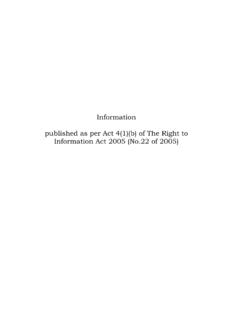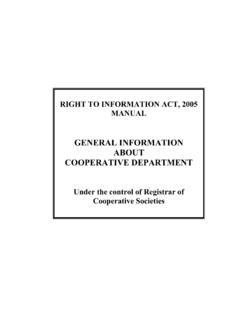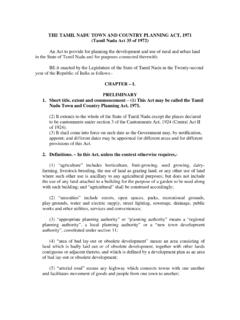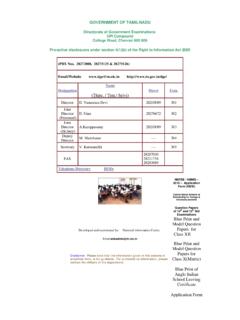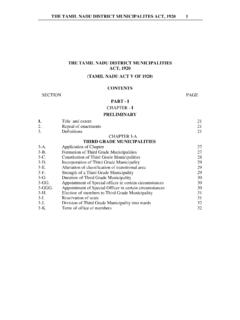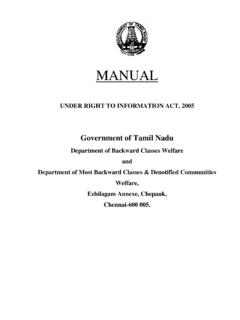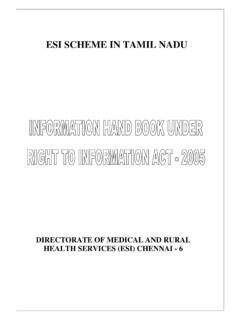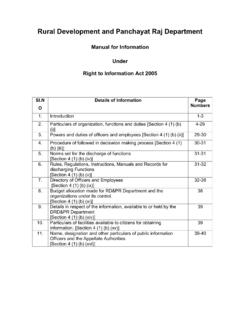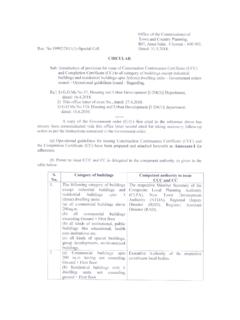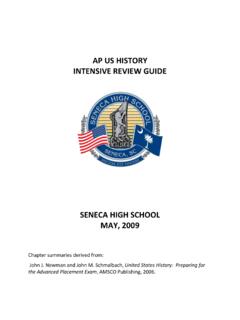Transcription of RIGHT TO INFORMATION ACT, 2005
1 2. RIGHT TO INFORMATION ACT, 2005 . Chapter Page No. 1. Introduction 1 3. 2. Particulars of Organisations, Functions and Duties 4 17. 3. Powers and Duties of Officers and Employees 18 21. 4. List of Rules, Regulations, Instructions, Manual for 22. discharging functions 5. Official Documents 23. 6. INFORMATION on Boards, Councils and Committees 24. 7. Names, Designation and other particulars of the 25 27. Public Authority 8. Procedure followed in decision making process 28 31. 9. INFORMATION about the Officers 32 34. 10. Salaries and Allowances 35. 11. INFORMATION about the details of the Budget for 36. different activities under different schemes 12.
2 The manner of execution of Subsidy Programmes 37. 13. Particulars of Recipients of Concessions, permits or 38 45. authorization granted by it 14. Norms set by the Department for the discharge of its 46 47. function 15. INFORMATION available on an electronic form 48. 16. Particulars of facilities available to citizens for 49. obtaining INFORMATION 17. Frequently asked questions and their answers by 50 53. Public, draft Application Form, etc. 3. RIGHT TO INFORMATION ACT, 2005 . INFORMATION HAND BOOK. CHAPTER-I. INTRODUCTION. The RIGHT to INFORMATION Bill, 2005 as passed by the Houses Background, Objective and of Parliament received the assent of the President of India on 15th Purpose of this June, 2005 and thus the RIGHT to INFORMATION Act, 2005 (Central Act Hand-Book 22 of 2005 ) has come into force.
3 The provisions of sub-section (1) of section 4, sub section (1). and (2) of section 5, section2 12, 13, 15, 16, 24, 27 and 28 of the Act came into force at once and the remaining provisions of Act came into force on the 12th October, 2005 . The RIGHT to INFORMATION Act, 2005 (Central Act 22 of 2005 ). has been enacted to provide for setting out a practical regime of the RIGHT to INFORMATION for citizens to secure access to INFORMATION under the control of Public authorities, in order to promote transparency and accountability in the working of every Public authority. To provide INFORMATION to citizens who desire to have it and contain corruption and to hold Government and their instrumentalities accountable to the governed keeping in mind the preservation of confidentiality of sensitive INFORMATION .
4 The Public, Officers and Staff of organizations under the Intended users of this administrative control of Public Department will be the users of this book. Hand Book The organization of the INFORMATION in this Hand Book is given Organisation of the Chapter-wise in the index. INFORMATION /. 4. Public INFORMATION Officers , all the Under Secretaries to Contact person Government, Public Department, Secretariat, Chennai-9. The Deputy Secretary to Government (Law & Order) is the Public INFORMATION Officer in respect of Law and Order Wing. , Public ( & Leg.) Dept., Procedure and fee structure for a) Every application for obtaining INFORMATION under sub-section getting (1) of the section 6 of the Act shall be accompanied by an INFORMATION .
5 Application fee of by way of cash or Demand Draft or Bankers Cheque payable in the head of account Miscellaneous General Services 800. Other receipts BK. Collection of fees under Tamil Nadu RIGHT to INFORMATION (Fees) Rules 2005 (DPC 0075 00 800 BK 0006). The applicant may also remit the fee under the above head of account in the Treasury / Pay and Accounts Office / State Bank of India / Reserve Bank of India and produce the chalan to the Public INFORMATION Officer as an evidence for having remitted the fee. Court fee stamp can be affixed now. Court Fee Stamp can be affixed now. b) For providing the INFORMATION under sub-section (1) of section 7 of the Act, a fee shall be charged by way of cash against proper receipt or by Demand Draft or Bankers Cheque payable in the above head of account, at the following rates:- i) Rupees two for each page (in A-4 or A-3 size paper) created or copied.
6 Ii) Actual charge or cost price of a copy in larger size paper;. iii) Actual cost or price for samples or models; and iv) For inspection of records, no fee for the first hour, and a fee of rupees five for each one hour (or fraction thereof) thereafter. 5. c) For providing the INFORMATION under sub-section (5) of section 7, the fee shall be charged by way of cash against proper receipt or by Demand Draft or Bankers Cheque payable in the above head of account, at the following rates: i) for INFORMATION provided in diskette or floppy rupees fifty per diskette or floppy; and ii) for INFORMATION provided in printed form, at the price fixed for publication.
7 Persons below the poverty line are exempted from the payment of fee mentioned in the above para for seeking INFORMATION under the RIGHT to INFORMATION Act, 2005 . The list of persons below the poverty line as approved by the Gram Panchayat and local bodies will be the basis for claiming the concessions and the certified extract of the list will be sufficient to avail this concession. <> <> <>. 6. CHAPTER II. PARTICULARS OF ORGANISATIONS, FUNCTIONS AND DUTIES: The Public Department functions under the direct control of Objectives/. Purpose of the Chief Secretary and deals with certain important matters the Public Authority concerning the General Administration of the State.
8 Some of the and Mission/. important subjects dealt with by the Public Department are:- Vision Statement of the Matters relating to Law and Order public authority. Matters relating to IAS officers, District Revenue Officers and Secretariat Officers of the level of Deputy Secretary to Government and above excepting Law, Legislative Assembly, Finance and Planning, Development and Special Initiatives Departments. Protocol work Welfare of Refugees and Repatriates Grant of Pension to Freedom Fighters and their dependents and Ex-INA Personnel Welfare of Ex-servicemen and Administration of Ex-servicemen Corporation Chief Minister's Special Cell Maintenance of buildings within the Secretariat Campus Affairs of Inter-State Council and Southern Zonal Councils /.
9 National Integration Council Matters relating to Extension of issue of all kinds of visa to foreigners coming to India (except Pakistan & Bangladesh), Exit permission, Authentication of Certificates, documents, etc. Administration of Government Guest Houses in New Delhi, Chennai and Udhagamandalam Besides, it deals with matters relating to His Excellency the Governor and the Council of Ministers. It liaises with the Ministries of Defence, 7. External Affairs and Home on all matters of common interest between the State and the Central Government. It also looks after establishment matters relating to the personal staff of the Council of Ministers, provision of motor vehicles, stationery items, telephones and other office requirements of the Ministers.
10 Brief BRIEF HISTORY: History of the public This Department is the largest Department in the Tamil Nadu authority. Secretariat. Initially, it was known as Chief Secretariat as this was the main Department controlling the major important subjects of Secretariat under the direct control of the Chief Secretary and also under the control of the Hon'ble Chief Minister. Subsequently, owing to the increase in the subjects, it was decided to delink all administrative matters in a separate Department. Thus, Personnel &. Administrative Reforms Department was culled out from this Department. Chief Secretariat is now known as Public Department, which consists of 57 sections.
